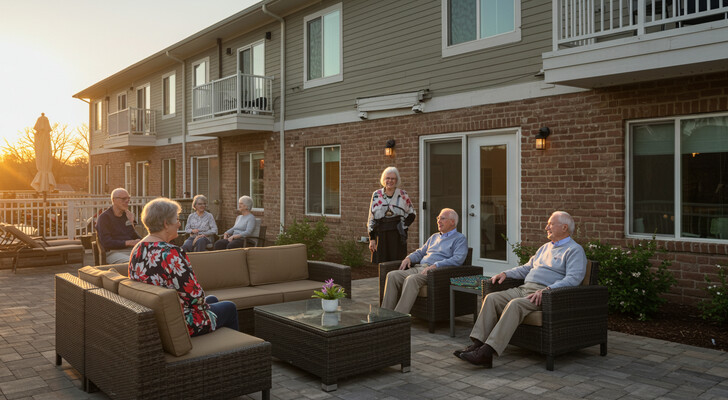
As more seniors seek ways to maintain independence while staying socially connected, senior co-housing has emerged as a popular and innovative housing option. This unique living arrangement offers the best of both worlds: private homes where seniors can enjoy their personal space, alongside shared common areas that foster community, friendship, and mutual support. Communities like Silver Sage Village in Colorado showcase how co-housing can enrich the retirement experience, promoting well-being and companionship in a welcoming, collaborative environment.
What is Senior Co-Housing?
Senior co-housing is an innovative living arrangement where older adults each have their own private home but share common areas such as kitchens, gardens, workshops, and recreation rooms. This approach blends independence with community living, giving residents the privacy they value along with the companionship and support that comes from being part of a close-knit neighborhood. A well-known example is Silver Sage Village in Colorado, one of the first senior co-housing communities in the United States.
How Senior Co-Housing Works
In a senior co-housing setup, each resident owns or rents their private space, which typically includes a bedroom, bathroom, living area, and small kitchen. The community also maintains shared facilities that encourage social interaction, such as large kitchens for group meals, landscaped gardens, hobby rooms, and exercise spaces. These shared areas are co-managed by the residents, allowing everyone to have a say in how the community operates.
Building a Sense of Community
One of the defining features of senior co-housing is its emphasis on fostering strong social connections. Regular community meals, group activities, and shared projects encourage residents to bond and support each other. This creates a family-like atmosphere where neighbors not only socialize but also look out for one another’s wellbeing. The emotional support found in co-housing can be invaluable, especially for seniors who might otherwise face loneliness or isolation.
Health and Wellness Benefits
Living in a senior co-housing community has notable health advantages. The social engagement and active lifestyle promoted by these communities help reduce stress and improve mental health. Access to shared walking paths, fitness rooms, and gardening areas encourages physical activity, which is essential for maintaining mobility and overall health in later years. Additionally, having neighbors close by means help is readily available in case of emergencies, adding a layer of safety and peace of mind.
Environmental Sustainability in Co-Housing
Many senior co-housing communities prioritize sustainable living. Shared resources and communal spaces reduce overall consumption and waste. Some communities incorporate green building materials, solar panels, and community gardens that promote locally grown food. This environmentally conscious approach appeals to seniors interested in reducing their ecological footprint while enjoying a supportive living environment.
Cost Considerations for Senior Co-Housing
The cost of senior co-housing can vary widely depending on factors such as location, property size, amenities, and whether the arrangement is a purchase or rental model.
1. Initial Purchase Costs: In communities where homes are owned rather than rented, prices can range from $150,000 in smaller towns to $500,000 or more in high-demand urban areas. These figures are often comparable to condominium prices in the same region.
2. Monthly Fees: Residents usually contribute between $300 and $800 per month to cover shared expenses such as utilities, landscaping, facility maintenance, and community programming.
3. Rental Options: In rental-based senior co-housing, monthly rents often fall between $1,200 and $3,500, depending on the size of the unit and included amenities.
4. Long-Term Savings: While upfront costs can be similar to traditional housing, co-housing can reduce long-term expenses because residents share resources such as appliances, tools, and even transportation. Many residents also find they spend less on dining out and entertainment because of frequent community meals and activities.
5. Geographic Examples:
- Boulder, CO: Purchase prices around $400,000–$550,000, monthly fees $500–$750
- Sacramento, CA: Purchase prices $250,000–$400,000, monthly fees $400–$600
- Asheville, NC: Purchase prices $200,000–$350,000, monthly fees $300–$500
- Minneapolis, MN: Purchase prices $180,000–$300,000, monthly fees $350–$550
Compared to traditional retirement communities, senior co-housing can be more affordable long term, particularly because residents maintain control over costs and benefit from the economic efficiency of shared living.
Who is Senior Co-Housing For?
Senior co-housing is ideal for older adults who value autonomy but want to avoid the isolation that sometimes comes with living alone. It’s particularly appealing to those who enjoy collaborative decision-making and shared responsibilities. Residents often form deep friendships, participate in group activities, and work together to keep the community thriving. This makes it a good fit for seniors looking for a socially active and supportive environment.
Frequently Asked Questions About Senior Co-Housing
– What is the difference between senior co-housing and a retirement community?
Senior co-housing emphasizes private homes combined with shared common spaces managed by residents, promoting collaboration and community decision-making. Traditional retirement communities often have more structured management and may include assisted living services.
– Is senior co-housing affordable compared to other senior living options?
Costs vary, but senior co-housing can be more affordable long term due to shared expenses for maintenance and utilities. The social benefits may also reduce healthcare and caregiving costs over time.
– Are senior co-housing communities safe?
Yes. These communities typically have strong neighbor connections, creating a natural support network that enhances safety. Many also include security features similar to other residential neighborhoods.
– Can seniors with mobility challenges live in co-housing?
Many senior co-housing communities design homes and common areas to be accessible. However, those with significant mobility or health needs should verify the community’s accommodations before moving in.
– How do residents share responsibilities in co-housing?
Residents usually participate in committees or groups to manage gardening, cleaning, events, and community decisions. This collaboration fosters a sense of ownership and belonging.
– Where can I find senior co-housing communities?
While still growing in popularity, senior co-housing communities exist across the U.S. Examples include Silver Sage Village in Colorado and others in California, Minnesota, and beyond. Searching “senior co-housing near me” can help locate local options.
Closing Thoughts
Senior co-housing offers a fresh alternative to traditional retirement living, combining the comfort of a private home with the warmth and connection of a supportive neighborhood. Communities like Silver Sage Village in Colorado show how this model can create vibrant, engaged lifestyles for older adults. For seniors who want to age in place while staying connected and active, co-housing can be a fulfilling and sustainable choice.


